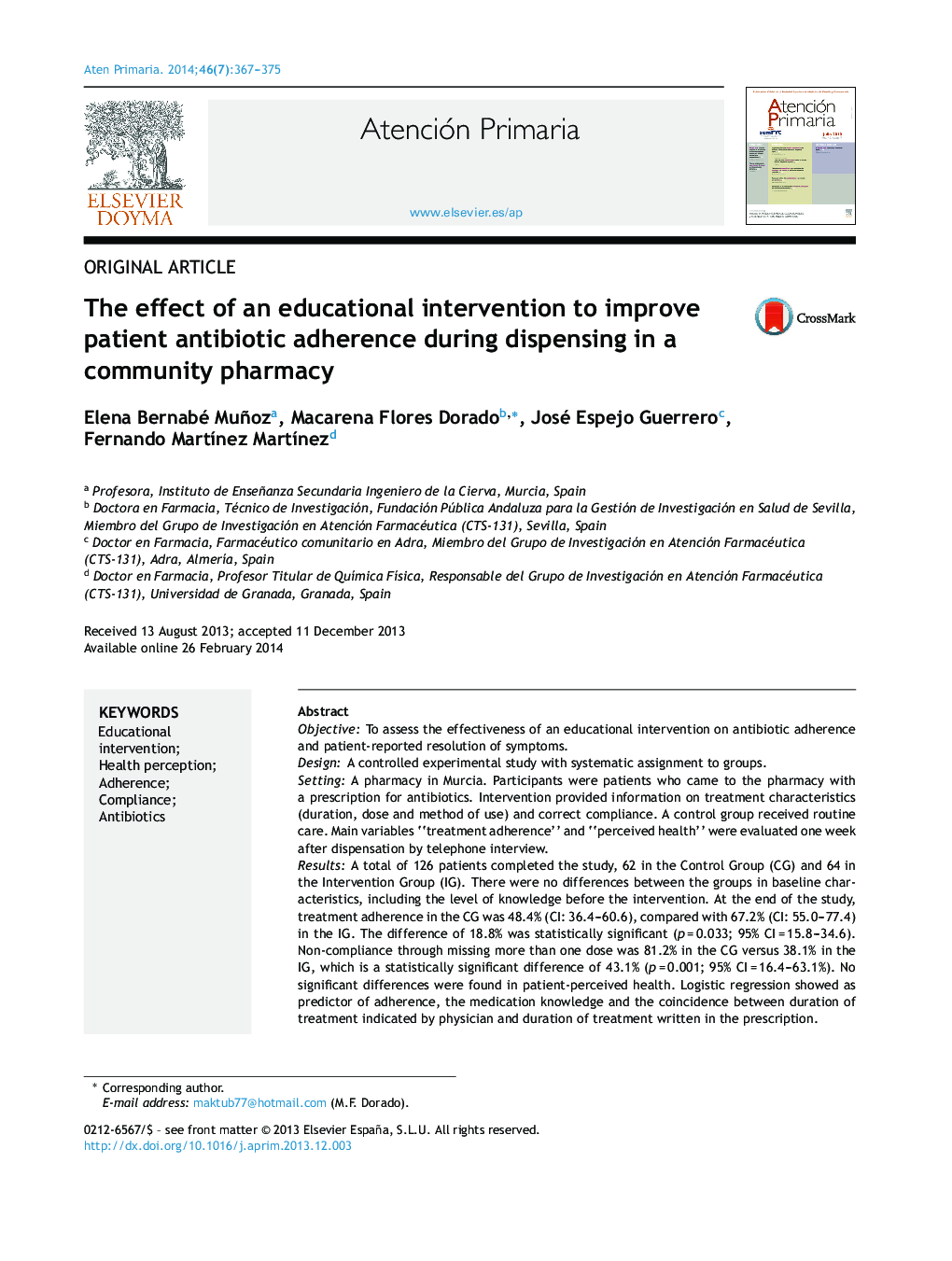| کد مقاله | کد نشریه | سال انتشار | مقاله انگلیسی | نسخه تمام متن |
|---|---|---|---|---|
| 3457554 | 1230917 | 2014 | 9 صفحه PDF | دانلود رایگان |
ObjectiveTo assess the effectiveness of an educational intervention on antibiotic adherence and patient-reported resolution of symptoms.DesignA controlled experimental study with systematic assignment to groups.SettingA pharmacy in Murcia. Participants were patients who came to the pharmacy with a prescription for antibiotics. Intervention provided information on treatment characteristics (duration, dose and method of use) and correct compliance. A control group received routine care. Main variables “treatment adherence” and “perceived health” were evaluated one week after dispensation by telephone interview.ResultsA total of 126 patients completed the study, 62 in the Control Group (CG) and 64 in the Intervention Group (IG). There were no differences between the groups in baseline characteristics, including the level of knowledge before the intervention. At the end of the study, treatment adherence in the CG was 48.4% (CI: 36.4–60.6), compared with 67.2% (CI: 55.0–77.4) in the IG. The difference of 18.8% was statistically significant (p = 0.033; 95% CI = 15.8–34.6). Non-compliance through missing more than one dose was 81.2% in the CG versus 38.1% in the IG, which is a statistically significant difference of 43.1% (p = 0.001; 95% CI = 16.4–63.1%). No significant differences were found in patient-perceived health. Logistic regression showed as predictor of adherence, the medication knowledge and the coincidence between duration of treatment indicated by physician and duration of treatment written in the prescription.ConclusionsAn educational intervention during antibiotic dispensation improves treatment adherence versus routine care.
ResumenObjetivoEvaluar la efectividad de la intervención educativa en la adherencia al tratamiento con antibióticos y en la evolución de los síntomas referidos por el paciente.DiseñoEstudio experimental controlado con asignación sistemática. Emplazamiento: farmacia comunitaria en Murcia. Participantes: pacientes que acudieron a la farmacia con una receta de antibiótico.IntervenciónAportar información sobre las características del tratamiento (duración, pauta y forma de utilización) y la correcta adherencia. En el grupo Control se procedió a una venta habitual. Mediciones principales: se evaluaron la «adherencia al tratamiento» y la «percepción de salud» a la semana de la dispensación mediante entrevista telefónica.ResultadosFinalizaron el estudio 126 pacientes: 62 en el Grupo Control (GC) y 64 en el Grupo Intervención (GI). No hubo diferencias entre grupos en las características basales, incluido el nivel de conocimientos previo a la intervención. Tras la intervención, la adherencia al tratamiento en el GC fue del 48,4% (IC 95%: 36,4-60,6) frente al 67,2% (IC 95%: 55,0-77,4) del GI, siendo esta diferencia del 18,8% (p = 0,033; IC 95%: 15,8-34,6;). La falta de adherencia fue de más de una toma en el 81,2% GC vs el 38,1% GI, diferencia del 43,1% (p = 0,001; IC 95%: 16,4-63,1%). En la percepción de salud del paciente no se encontraron diferencias. La regresión logística mostró como predictor de adherencia el conocimiento de la medicación y la coincidencia entre la duración del tratamiento indicado por el médico y la duración del envase prescrito en la receta.ConclusionesUna intervención educativa durante la dispensación del antibiótico mejora la adherencia al tratamiento frente a una atención habitual.
Journal: Atención Primaria - Volume 46, Issue 7, August–September 2014, Pages 367–375
